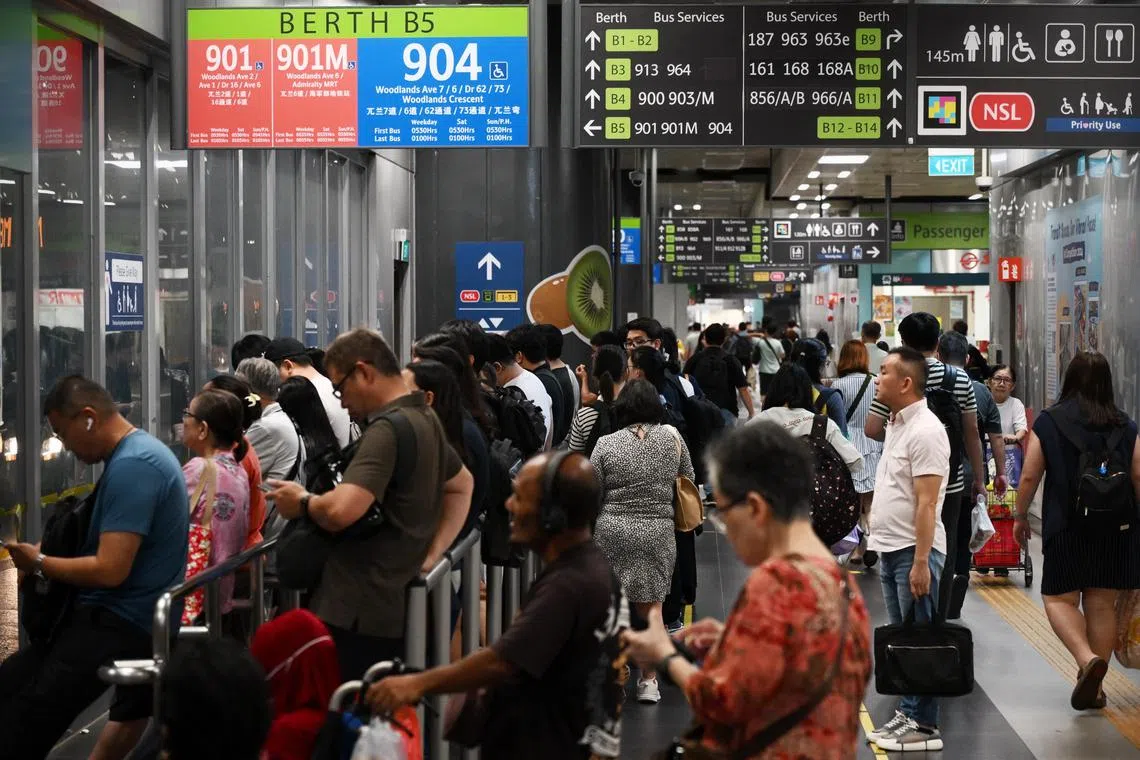More train rides taken in first half-year, but overall public transport use stays below 2019 levels
Sign up now: Get ST's newsletters delivered to your inbox

Public bus ridership fell to 3.82 million rides in the first half of 2025, down from 3.85 million for the same period in 2024.
ST PHOTO: KUA CHEE SIONG
Follow topic:
- Overall public transport ridership remains below pre-Covid-19 levels, with 7.47 million average daily trips in the first half of 2025, compared with 7.66 million in the first half of 2019.
- Train ridership increased, while bus ridership decreased. Weekday morning peak hour ridership is also still lower than pre-pandemic levels.
- Experts point to flexible work arrangements and the expanded rail network as reasons for the shift in travel patterns, noting potential implications to costs and subsidies.
AI generated
SINGAPORE – In the first six months of 2025, more rides were taken every day on Singapore’s MRT and LRT lines on average, while the number of daily bus rides fell slightly, from the same period the year before.
But according to the latest figures, overall public transport ridership remains below pre-Covid-19 levels six years later, standing at 7.47 million daily trips on average between January and June.
In comparison, an average of 7.66 million daily bus and train rides were logged in the first half of 2019. This is 2.5 per cent, or about 195,000, more than today’s numbers.
Experts said the data provided to The Straits Times by the Land Transport Authority (LTA) is consistent with a shift away from buses towards an expanding rail network, as well as a structural change in travel patterns
After recovering fully in 2024, train ridership here continued to grow to an average of 3.65 million rides a day between January and June.
This is up from an average of 3.57 million daily rides over the same period in 2024, and higher than the 3.56 million recorded in the first half of 2019.
Public bus ridership, on the other hand, fell to an average of 3.82 million rides daily, down from 3.85 million in the first half of 2024.
In comparison, there was an average of 4.1 million public bus trips daily in the first half of 2019, before the pandemic struck.
Another notable trend is that public transport ridership during weekday morning peak hours continues to be lower than before Covid-19.
The average daily number of rides taken during the morning rush stood at 1.48 million between January and June, down from 1.55 million six years ago.
NUS economist Timothy Wong said it is not surprising to see bus ridership fall as the rail network increasingly becomes the backbone of the public transport system.
What is surprising is that rail ridership growth has been relatively flat.
“This, and the fact that peak travel is down, speaks to the structural change that took place during the pandemic, allowing more workers to work from home and work with more flexible hours,” Dr Wong added.
Train stations being located closer to homes is another potential reason bus ridership has not fully recovered, as passengers can walk or cycle there, rather than take the feeder bus, said Singapore University of Technology and Design researcher Samuel Chng.
“We do see a rebalancing of people’s travel behaviours and patterns,” Dr Chng added, pointing to LTA’s goal of having eight in 10 households be within a 10-minute walk of a train station by the 2030s.
However, transport economist Walter Theseira said that while overall public transport ridership remains lower today than in 2019, there may be little improvement in the daily passenger experience if a high mass of people continue to travel on the same routes during the same peak hours.
The associate professor at the Singapore University of Social Sciences said policymakers need to continue encouraging more people and companies to shift their employment to areas outside the Central Business District, and encourage more flexible travel timings.
As more MRT lines are built, older trunk lines like the North-South and East-West lines will also become less congested, he noted.
Since 2019, Singapore has completed 43km of new rail – opening the first four stages of the Thomson-East Coast Line (TEL), the Punggol Coast extension of the North East Line and Hume station on the Downtown Line (DTL).
In 2026, the sixth stage of the Circle Line will open, as will a 2.2km DTL extension in the east and the fifth stage of the TEL, which comprises Bedok South and Sungei Bedok stations.
The Jurong Region and Cross Island lines – Singapore’s seventh and eighth rail lines – will open in phases from 2027 and 2030, respectively. Another two new MRT lines are also under study.
NUS’ Dr Wong said a growing rail network without commensurate growth in ridership means higher costs without higher revenue.
But he believes rail expansion will translate into a higher-quality product that passengers should, in theory, be willing to pay more for as there will be less crowding and better connectivity.
Prof Theseira believes public transport subsidies may need to rise, noting that the new MRT lines could cannibalise demand from older lines.
“There is limited room to cut services... And indeed, the Government has already signalled that it will further expand services to meet commuter needs,” he added.
In 2024, LTA said it will spend up to $900 million over eight years
Prof Theseira said it is not necessarily a bad thing for government subsidies to go up if the public benefits from more convenient and direct journeys.
“However, at some point, cost-effectiveness also has to be looked into, given competing demands for tax funding,” he added.
Dr Chng said both buses and trains play important roles as they provide alternatives to commuters, and the introduction of autonomous vehicles could change the landscape as they allow for greater flexibility in bus route planning and can operate on demand.
“From a whole system point of view, you want to increase the service level to make public transport attractive, so more people will use it,” he added.


